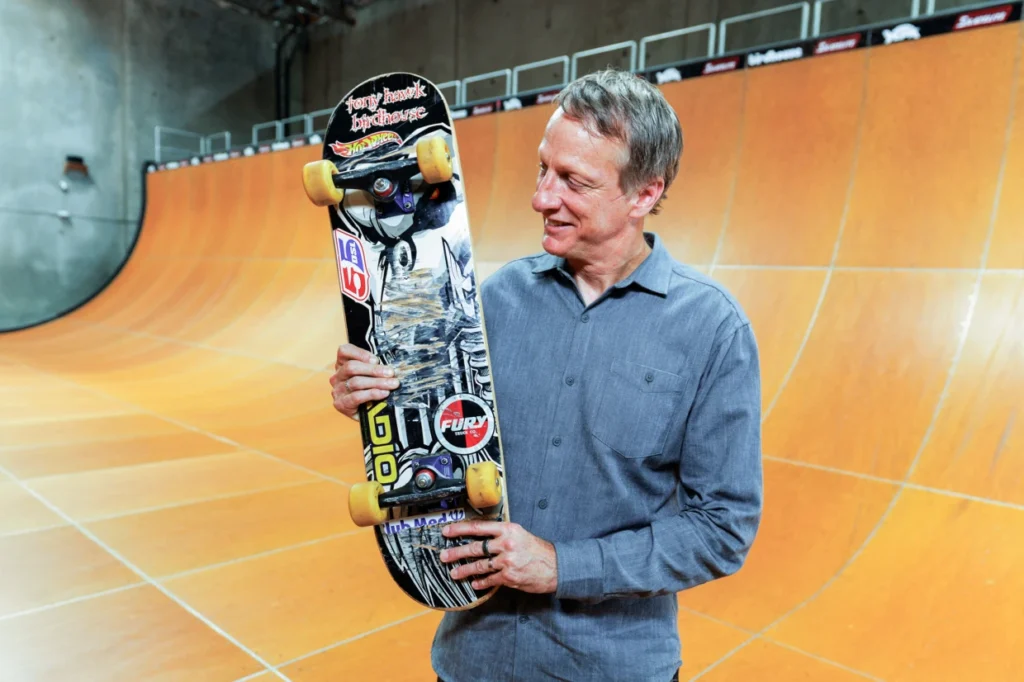On September 23, 2025, skateboarding history crossed into the rarefied air of high-end auctions. A skateboard once launched into legend beneath the feet of Tony Hawk — the same board that carried him through the world’s first landed “900” at the 1999 X Games — sold for an astonishing $1.15 million at Julien’s Auctions. More than a collectible, the deck is a cultural artifact, representing a moment when skateboarding leapt from subculture to global phenomenon.
This sale, titled “Tony Hawk: The 900 Collection,” included not only the famed deck but also gear Hawk wore that day. Yet it was the board itself, Birdhouse’s “Falcon 2” model, that broke barriers — both in the air and on the auction block.
A Trick That Changed Everything
In 1999, the X Games were still defining themselves, trying to strike a balance between spectacle and sport. For years, Tony Hawk had been chasing a trick whispered about in skating’s back channels: the 900. The move required two and a half full rotations in the air, pushing human balance and physics to their limits on a vert ramp.
Hawk had come close many times before, often spinning out or collapsing on landing. But on a warm San Francisco night in June 1999, after a string of failed attempts, he finally landed it before an electrified crowd. Commentators erupted, fellow skaters rushed the ramp, and within hours the footage was circulating worldwide. Hawk’s 900 was more than just a personal triumph; it became a symbol of persistence, progression, and skateboarding’s arrival on the global stage.
The board under his feet during that trick was not just a tool — it was a vessel of cultural momentum. That is why, twenty-six years later, collectors were willing to pay over a million dollars for it.
From Ramp to Auction House
Julien’s Auctions, known for handling rare entertainment and sports memorabilia, framed the sale as a landmark event. Estimates for Hawk’s board had hovered between $500,000 and $700,000. Even in a market where Michael Jordan sneakers or Babe Ruth bats fetch stratospheric sums, skateboarding had never commanded this kind of number.
When the gavel finally dropped at $1.15 million, the message was clear: skate culture has officially entered the pantheon of collectible history. The skateboard joins iconic artifacts not just of sport, but of cultural transformation.
The auction wasn’t limited to the deck. Hawk’s helmet sold for $115,200; his sneakers, scuffed from the ramps, went for $64,000; and the kneepads that absorbed countless failed attempts fetched $57,600. Even a 1982 Powell-Peralta pro model — a relic from Hawk’s early career — reached the same number.
Philanthropy in Motion
What makes the sale even more resonant is Hawk’s decision to funnel proceeds into The Skatepark Project (TSP), his nonprofit dedicated to building public skateparks in underserved communities.
For Hawk, this wasn’t merely about enshrining his legacy in private collections. It was about using history to fuel the future. By selling the board that once defied gravity, he is helping ground a new generation of skaters in communities that often lack safe, inclusive spaces to ride.
Hawk has long insisted that skateboarding saved him as a teenager, offering structure, identity, and purpose. In a statement before the auction, he emphasized:
“I hope that whoever owns this board appreciates it for what it represents — and also knows that it’s now helping to create opportunities for kids who need that same chance.”
The act transforms the board from a static relic into a dynamic contributor to skate culture’s future.
Why a Skateboard Is Worth $1.15 Million
For outsiders, it might be baffling: how can a piece of wood, griptape, and wheels command such a sum? But collectors and cultural historians point to several factors.
-
Provenance: This wasn’t just any deck — it was the board from the trick. Documentation, photos, and Hawk’s own confirmation make its authenticity indisputable.
-
Cultural resonance: The 900 represents more than a move. It symbolizes skateboarding’s leap into mainstream consciousness, inspiring countless kids to pick up a board.
-
Scarcity: Unlike jerseys or baseball bats, skateboards used in singular, legendary feats are rarely preserved. Many are destroyed, discarded, or simply lost. This one survived.
-
Broader memorabilia boom: Sports collectibles have surged in recent years, as investors treat iconic items like fine art or vintage cars — cultural assets with emotional and financial value.
-
Philanthropic dimension: Buyers knew proceeds would fund skateparks. That knowledge added meaning, perhaps encouraging higher bids.
The convergence of these factors created the perfect storm for the sale.
Community Reactions
Within skateboarding circles, reactions have been layered. Some celebrated the validation: a skateboard, once dismissed as a toy, commanding a seven-figure price tag at an elite auction house. Others worried that skate culture, rooted in rebellion and accessibility, risks being commodified.
On forums, one skater joked: “Imagine telling 1999 me that my busted hand-me-down deck is worth more than a car.”Others speculated whether the buyer was an individual collector, a corporate brand, or perhaps even a museum planning to put the board on public display.
While the identity of the buyer remains anonymous, many hope the board won’t languish unseen in a vault. Its power lies in its story — a narrative best shared with the public, not hidden away.
Skateboarding’s Maturation
The auction underscores skateboarding’s transformation. Once a countercultural pursuit chased out of empty pools, it is now an Olympic sport with corporate sponsors and institutional recognition. Prices like $1.15 million don’t just reflect nostalgia; they reflect skateboarding’s arrival in the mainstream art and sport economy.
In many ways, the sale parallels the trajectory of hip-hop, punk, or graffiti — art forms once dismissed, now canonized, archived, and sold at Sotheby’s. While commercialization always brings tension, it also secures a place for skateboarding within global cultural memory.
Flow
The sale of Tony Hawk’s 900 skateboard is about far more than money. It is about legacy, memory, and the way objects can capture history. The deck that once spun through the air in San Francisco now carries the weight of skateboarding’s past, present, and future.
In setting a new auction record, the board immortalizes a trick that redefined possibility. In channeling proceeds toward building skateparks, it ensures that possibility lives on for the next generation.
One board. One trick. One night in 1999. And now, one million-plus dollars to carry it forward.
No comments yet.









